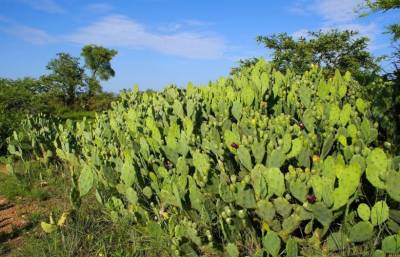DrCarney.com Blog
South-of-the-Border Goodness!
Cooking with Nopales For those uninitiated to the delights of nopales (or nopalitos as they are sometimes called), the taste of nopales has been described as a tart green bean or as a cross between asparagus and green beans. They can be eaten raw in salads or salsa, but are often steamed or pan "fried" with only enough water to prevent burning. The nopales have a rich "juice," similar to okra, which holds the secret to much of their nutritive value. Traditionally, nopales are eaten with pinto beans or tucked into tortillas with a little salsa, but as cuisines grow and merge, nopales are finding new plant-friendly recipes in which to spread their unique deliciousness.
Are Nopales Nutritious?
Nopales are low in calories but high in nutrients. They contain:
- Vitamin A and beta-carotene
- B-Vitamins: thiamin, riboflavin, niacin, B-5, B-6
- Vitamin C
- Minerals: calcium, potassium, magnesium, and iron
- Phytochemicals and anti-oxidants
Maybe one of the best properties of nopales is the fiber content. Nopales contain mucilage, pectin, and hemicellulose. This group of non-starch polysaccharides helps prevent constipation by softening stools and facilitating elimination. The fiber also helps reduce body weight and LDL-cholesterol while stabilizing blood sugar.
Science Loves this Latin Veggie!
Many scientific studies have looked at the benefits of the nopal cactus--both its paddles and its fruit, called prickly pears. The nopal cactus has been shown to have the following properties:
- anti-cancer
- anti-diabetic
- anti-inflammatory for the intestines
- antioxidant
- decreases LDL cholesterol
Watch Out When Taking Blood Sugar Lowering Meds
Those who are taking insulin, diabetes medication, or any type of drug that lowers blood sugar should be vigilant when adding nopales to their diet. Nopales have been shown to naturally decrease blood sugar, therefore careful monitoring is recommended so that blood sugar levels don't fall too low. The following is a partial list of medications which interact (click on the Interactions tab) with nopales:
- Chlorpropamide (Diabinese)
- Glyburide (Diabeta, Micronase)
- Glimepiride (Amaryl)
- Glipizide (Glucotrol)
- Insulin
- Metformin (Glucophage)
- Pioglitazone (Actos)
- Rosiglitazone (Avandia)
- Tolbutamide (Orinase)
Scroll Down Page to Leave Comments

Organized Resources to Share
Share our favorite whole-food plant-based no-oil Resources with your friends and for real meaningful sharing, invite them to Join Our Community.
Preview the "Diabetes in Retreat" Trailer
No More Meds?: Got a family history? Outsmart it! Decrease your need for medication naturally with Dr. Carney. Her patients can REVERSE Diabetes Type II. Which foods worsen insulin resistance? Find out now. Get the keys to lowering your insulin resistance with her proven methods for success. Finally, an MD who helps even Type 1 diabetics reduce insulin requirements using her Starch-Smart® System, a science-based plan to help you normalize weight and blood sugars.
When you subscribe to the blog, we will send you an e-mail when there are new updates on the site so you wouldn't miss them.




